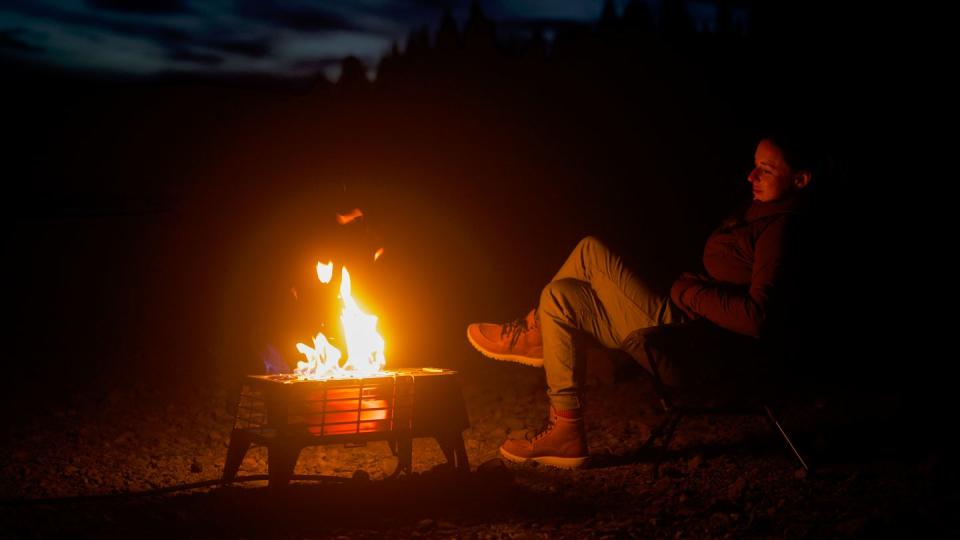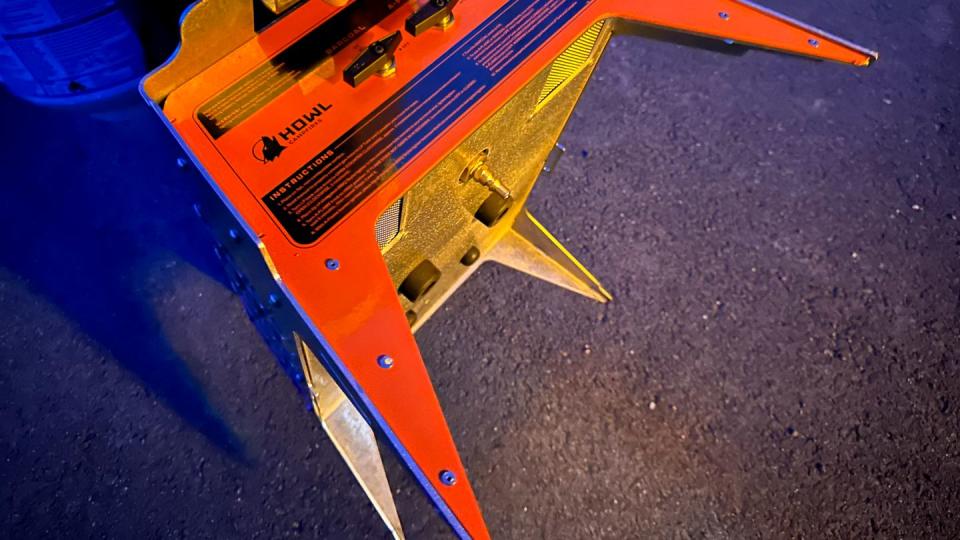This Is the Best Propane Campfire for Wood-Level Warmth

For the past few years, the Howl Campfires team has been teasing the release of its first propane-powered campfire model, the R4. In an effort to design a safe, cozy campfire that users can enjoy during burn bans, Howl’s research and design piqued the interest of the outdoor industry, the overlanding market, and the hunt-and-fish world. Now, the first model has finally hit the market, and I got to test it out and learn about the development and technology behind this eye-catching, bizarre portable campfire.
There are plenty of artificial campfires and smokeless fire pits on the market, many of which I’ve used on camping trips during burn bans and at home on summer evenings. While the ambience has been nice, I’ve been underwhelmed—these are convenient and cool, but they mostly don’t compare to the heat of a real campfire.
As a gear writer embedded in the outdoor world, I’ve been following the development of the Howl R4 campfire since I first heard about it. When I got to use it on a chilly September night in Montana, I was pleasantly surprised at how well it lived up to the “feels like a real campfire” hype.
Currently, the Howl R4 is on preorder. To reserve yours, you can put a $100 deposit down at the link below, and we recommend it if you’re serious about buying one—these are projected to sell out between drops. If you aren’t ready to put money down, I recommend signing up for the email list or keeping tabs on Howl’s site and social media pages for restock alerts.

R4 Portable Propane Campfire
howlcampfires.com
$1299.00
The campfire was strapped down in the bed of the pickup, a 20-pound propane tank secured between the four angled steel legs. In person, the 34-pound R4 looks like a combination of a steampunk bulldog, a vintage truck grill, and a 1960s-era oven.
User-wise, the Howl campfire is pretty simple, with just two knobs and a propane attachment. The knobs control the two heat elements: the BarCoal burner and the A-Flame burner. The BarCoal is Howl’s heat-emitting steel bar that feels like hot campfire coals, and the A-Flame is the light-emitting, pyramid-shaped flame similar to what you see on other propane campfires. The A-Flame is adjustable for a range of flame heights, whereas the BarCoal is either on or off.

We hooked up the propane, opened the fuel line, turned the knobs, and the flames whooshed to life, illuminating the sand. Within a few minutes the BarCoal was glowing reddish orange and blasting heat. The combination of steady heat and bright flames created enough of a campfire vibe that I had to remind myself it was actually coming from a little steampunk-looking steel campfire hooked up to a propane tank.
Here are the details on Howl Campfires’ first release, and where you can put a deposit down for your own.

The Howl R4 Actually Feels like a Campfire
The whole unit was designed to emulate a campfire, but the warmth from the BarCoal—sending radiant heat outwards instead of convective heat upwards—is what sets this apart from other artificial campfires.
People gather around real campfires because the heat projects outwards, but with the other propane campfires I’ve used, the heat rises, creating a column of hot air above the flames and not much else. They also don’t get nearly as hot as the Howl R4.
The proprietary BarCoal radiant heater reaches temperatures over 1,200 degrees Fahrenheit, roughly doubling other propane campfires, and it emits radiant heat instead of convective heat. Instead of heating the air the way a flame does, the physical steel tube of the BarCoal puts out infrared light at the exact same frequency as wood coals. These photons of light travel through the air and get absorbed by your body in the form of heat.
Howl didn’t invent the radiant tube heater—in fact, you’ve probably seen (and been warmed by) plenty of them in your life. Radiant tube heaters are typically found in buildings such as large warehouses, and most use a giant fan to draw in the air necessary for combustion.
The Howl team wanted to create the radiant heat, but needed a way to pull in air without a fan or electricity. They ended up figuring out how to utilize the latent pressure built up in the propane tank to send fuel across an air gap, creating the fuel-to-air ratio needed for efficient combustion. The result is the first miniature, naturally aspirated, portable radiant tube heating system, and it was the crux of the entire design.

The other “feels like a real campfire” element is the flame itself. Howl’s A-Flame gets its name from the pyramid shape of the flame, recreating the taller stack height of a wood-fueled fire. This was accomplished with a unique aluminum burner plate instead of the traditional copper pipe. The plate is perforated with a dense cluster of smaller holes that create the precise fluid and combustion dynamics for a robust flame and a clean, bright burn.
It Stays Lit (and Warm) in Wind, Rain, and Snow
The Howl team debuted its first working prototype at a cold, wet, industry event this past summer. There was a bonfire at one end of the lot, but people moved away from the smoke and started gathering around the Howl R4 instead. On a whim, Howl co-founder Alex Tenenbaum grabbed the edge of an overhead canopy sagging with water and pulled it down, dumping gallons of water on the unit. The flames sank for a moment, then reignited off the BarCoal within seconds, and the BarCoal never went out.
“You can pull this out from under a foot of snow, shake it off, and light it up,” says Tenenbaum, mentioning testing and development trips where the Howl R4 functioned at peak performance on mountain passes at 12,000 feet, while being blasted with 40-mile-per-hour winds, and in torrential downpours.
It’s Approved for Level 1 and 2 Burn Bans
Another element that caught my eye before the R4’s release was Howl’s statement that the company “exists to keep the forest and campfire alive.” I’ve been monitoring the trajectory of wildfire seasons and burn bans as they impact my life in Montana, my summer plans, and my thru-hikes.
Each season brings more burn bans that start earlier, are wider spread, and last longer. If things keep going this direction, we might be seeing the end of campfires.
While you won’t take this chunk of steel backpacking, it can be the answer to having a legal campfire during a burn ban, whether you’re base camping, overlanding, car camping, fly fishing, or at your hunting camp.

The unit’s EchoHeat Reflectors mean the heat only goes out and up, so while the ground was just inches beneath the 1,200-degree BarCoal, the sand and pebbles below were cool to the touch. It doesn’t leave ash or a fire ring, so you can plop it in your backyard without killing your grass or starting a neighborhood fire—something even smokeless fire pits haven’t solved yet.
Since there are no embers or sparks, it’s safer to use during dry conditions, and Howl has a UL Certification that makes it legal to use in all 50 states during Stage I and II, or Level 1 and 2, burn bans. The R4 has passed the rigorous ANSI Z21.97 safety standard, falling into the Outdoor Decorative Gas Appliance category.
The Howl R4 Is an Investment
Here’s the downside of the Howl R4 campfire: it’s pricey. A combination of expensive materials, entirely U.S.-based manufacturing, and a time- and labor- intensive manufacturing process means this campfire costs a lot more than anything else on the market. Retailing for $1,299, I see it in a similar cross-category as Go Fast Campers, Yeti coolers, and Sitka gear—brands with much higher price points than competitors, all of which raised eyebrows when they first debuted.
The price point will certainly exclude many customers. It’s a high-tech product that produces more heat and a better campfire experience, but you’ll pay a steeper price for it.

The Howl Campfire R4, Reviewed
The Howl Campfire R4 is an advanced, one-of-a-kind propane fire that actually feels like a campfire, achieving something no other brands have managed to do.
The three modes—“Campfire” with both heaters on, “Lantern” with just the A-Flame, and “Stargazing” with just the BarCoal—replicate the feeling of sitting around the fire from when you first light it to the end of the night, sitting around glowing coals.
At full blast, one 20-pound propane tank will last 6.5 hours, and that time doubles if you use Lantern or Stargazing mode. It’s easy to transport with the propane tank secured between the legs, and you can safely transport it within 45 minutes of shutting down the heat.
It’s durable, windproof, and weatherproof, and if you manage to damage it, Howl will repair or replace the affected parts at a reasonable cost. I think this will be a game changer for a sector of the outdoor market, and I’m keeping my eyes peeled for the next product restock.
You Might Also Like

 Yahoo Autos
Yahoo Autos 